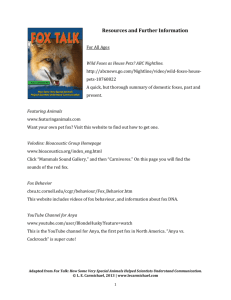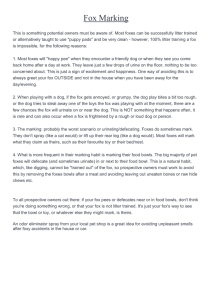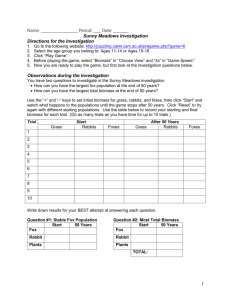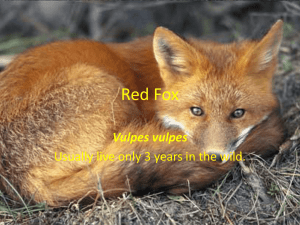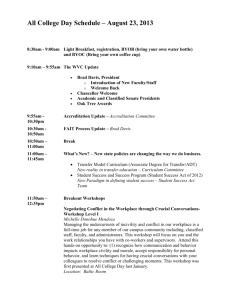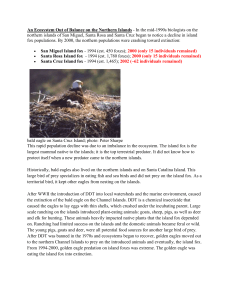TA for the day write-up
advertisement
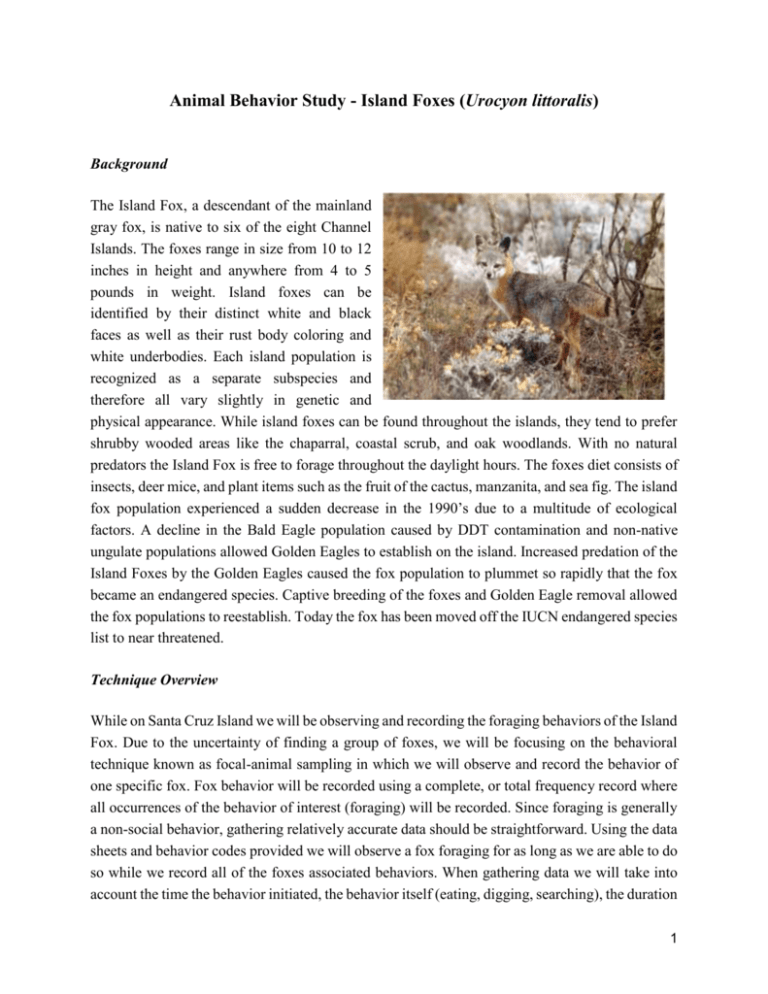
Animal Behavior Study - Island Foxes (Urocyon littoralis) Background The Island Fox, a descendant of the mainland gray fox, is native to six of the eight Channel Islands. The foxes range in size from 10 to 12 inches in height and anywhere from 4 to 5 pounds in weight. Island foxes can be identified by their distinct white and black faces as well as their rust body coloring and white underbodies. Each island population is recognized as a separate subspecies and therefore all vary slightly in genetic and physical appearance. While island foxes can be found throughout the islands, they tend to prefer shrubby wooded areas like the chaparral, coastal scrub, and oak woodlands. With no natural predators the Island Fox is free to forage throughout the daylight hours. The foxes diet consists of insects, deer mice, and plant items such as the fruit of the cactus, manzanita, and sea fig. The island fox population experienced a sudden decrease in the 1990’s due to a multitude of ecological factors. A decline in the Bald Eagle population caused by DDT contamination and non-native ungulate populations allowed Golden Eagles to establish on the island. Increased predation of the Island Foxes by the Golden Eagles caused the fox population to plummet so rapidly that the fox became an endangered species. Captive breeding of the foxes and Golden Eagle removal allowed the fox populations to reestablish. Today the fox has been moved off the IUCN endangered species list to near threatened. Technique Overview While on Santa Cruz Island we will be observing and recording the foraging behaviors of the Island Fox. Due to the uncertainty of finding a group of foxes, we will be focusing on the behavioral technique known as focal-animal sampling in which we will observe and record the behavior of one specific fox. Fox behavior will be recorded using a complete, or total frequency record where all occurrences of the behavior of interest (foraging) will be recorded. Since foraging is generally a non-social behavior, gathering relatively accurate data should be straightforward. Using the data sheets and behavior codes provided we will observe a fox foraging for as long as we are able to do so while we record all of the foxes associated behaviors. When gathering data we will take into account the time the behavior initiated, the behavior itself (eating, digging, searching), the duration 1 of the behavior, location at the time the behavior was exhibited, intraspecies interactions, and any other relevant notes. Benefits ❖ Total frequency records of individual animals provide insight into behavioral patterns including: time of foraging, duration of foraging, habitat preference, dietary preference, and intraspecies interaction patterns. ❖ Long term insight into any changes in the species preferences or food availability. ❖ Keeping records of food intake of the foxes can potentially show changes in other related species Limitations ❖ ❖ ❖ ❖ Inability to move close enough to the fox to discern the specific food item the fox is eating Inability to locate any subjects to observe Weather variability leading to undesirable foraging conditions for the foxes. Limitations of the food diversity at a particular site may skew data Considerations ❖ Time ➢ We will be observing the Island Fox in the late afternoon when we are most likely to find them foraging. There is a possibility that we will not be able to locate an individual to observe so, should we find one, it is vital that we be prepared and ready to collect data to utilize all of our time. ❖ Equipment ➢ Binoculars ■ If we are not able to approach the fox, we may need binoculars to identify what type of food the fox is eating ➢ Data sheets, clipboards, writing utensils ■ We may not have any flat surfaces to write on so clipboard may be helpful ➢ Behavior code guide ■ Gives shorthand codes for all aspects of the data collection to allow for quick and concise data recording Data Sheet 2 ❖ Behavior Code Guide ➢ The behavior code guide breaks down the behavior of interest into three categories, one of them being the location at which the event occurred ➢ Each behavior or event and the location should be recorded on the data sheet using the shorthand codes provided below Category Foraging Behaviors Behavior Definition Searching Clearly looking for food but not actively trying to get to a food item or eat a food item FS Digging Digging through dirt or leaf litter in order to reach a food item FD Climbing Climbing up a tree in order to reach a food source FC Eating The act of consuming the acquired food item FE Open Field An open space in which the fox is not hidden by any shrubbery LO Small shrubs, small trees, cacti LC Up in a Tree Any tree that is clearly taller that the chaparral and coastal shrubs LT Startled Fox stops foraging and turns attention to a new stimuli ES Leaving Fox leaves visible range EL Intraspecies Interaction Friendly Any interaction between the fox and another animal that does not result in a conflict/fox leaving the area EF Intraspecies Interaction Aggressive Any conflict that may arise between the fox and another animal (hissing, fighting) EA Foraging/ Event Locations Chaparral Behavior Events Code ❖ Data Sheet ➢ The data sheet provides a heading to record the name of the observer, location, date, start time, end time, and weather. ➢ Below the header is the listing of all relative data points that need to be collected. ➢ For each instance of behavior the initial time of the behavior, the type of behavior, the location of the behavior, the duration of the behavior, and any additional notes will be recorded. 3 Alternative Techniques ❖ Partial frequency sampling - takes record of only a one specific behavior and does not necessarily represent all the behaviors displayed by a particular animal. ❖ One-zero sampling - takes record of whether a behavior did or did not ( one or zero) occur and not the frequency at which the behavior occurred. 4

